|
.
|
Many of the books shown below are long out of print. Basically I would have thought that if you can't order them by title from Amazon, it will be a matter of searching through old book shops.
Please feel free to contact me if you want specific information about any volume.
|
|
|
A long-time classic. Published by Penguin, this book recounts the 1000-year story of Tangrams. It includes a detailed bibliography, as well as 1600 puzzles and a mathematical  section which discusses the number of possible shapes which can be made. Tangrams is probably one of the first mechanical puzzles I encountered as a young whipper-snapper, and I lost my enthusiasm for it by my early teens, but in recent years I have come to greatly enjoy its timeless mathematical beauty and elegance. Many of the puzzles are truly frustrating, and consequently I have several different sets. Its longevity is clear from the fact that it is constantly commercially available. I have a spare copy. section which discusses the number of possible shapes which can be made. Tangrams is probably one of the first mechanical puzzles I encountered as a young whipper-snapper, and I lost my enthusiasm for it by my early teens, but in recent years I have come to greatly enjoy its timeless mathematical beauty and elegance. Many of the puzzles are truly frustrating, and consequently I have several different sets. Its longevity is clear from the fact that it is constantly commercially available. I have a spare copy.
"A Handbook of Cube-Assembly Puzzles using Polycube  Shapes" is self-produced by Kevin Holmes. This A5 booklet is a work of great dedication. Kevin clearly loves the whole concept of polycube assemblies. It covers a wide range of 3x3x3, 4x4x4 and even 5x5x5 cube assemblies, designed by some of the puzzle world elite. The booklet includes hints for designing and manufacturing your own puzzles, as well as clear diagrams of each piece and a series of conventions for representing the constituent 3D pieces on paper. It also grades each puzzle for difficulty and number of solutions, and provides (sealed) solutions for most of the puzzles. My solutions are still sealed!Volume two, a significant revision, is now available. Shapes" is self-produced by Kevin Holmes. This A5 booklet is a work of great dedication. Kevin clearly loves the whole concept of polycube assemblies. It covers a wide range of 3x3x3, 4x4x4 and even 5x5x5 cube assemblies, designed by some of the puzzle world elite. The booklet includes hints for designing and manufacturing your own puzzles, as well as clear diagrams of each piece and a series of conventions for representing the constituent 3D pieces on paper. It also grades each puzzle for difficulty and number of solutions, and provides (sealed) solutions for most of the puzzles. My solutions are still sealed!Volume two, a significant revision, is now available.
|
Subtitled 'Intriguing projects You Can Make' the jacket describes the 21 projects as 'well within the scope of the average craftsman.'
|
|

|
|
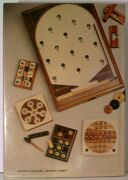
|
|
As well as clear and detailed instructions for cutting and making the puzzles and games, there are also sections on tools, preparation and wood finishes. It includes sliding puzzles, burrs, cubes, chess boards, pentominoes, assemblies and dexterity items. Excellent diagrams and numerous black and white photos.
|
|
|

|
|
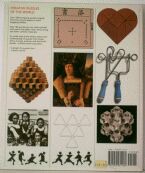
|
|
Jack Botermans with Pieter van Delft.
Possibly slightly more mathematical and less mechanically puzzling than the other similar books (see elsewhere on this page), this is still an invaluable resource to mathematician and puzzler alike. Full of ideas to inspire pencil-and-paper puzzlers and craftsmen alike. Get this book for your collection.
|
|
T he drab cover belies its intriguing contents. This book describes very clearly and simply, and illustrates with beautiful (sadly only black and white) photographs of models, a great number of three dimensional figures, all but a few consisting of plane faces bounded by straight lines. It includes many variations of regular solids, often obtained by truncation, stellation, dualization and compounding. 219 photos and 100 line drawings. he drab cover belies its intriguing contents. This book describes very clearly and simply, and illustrates with beautiful (sadly only black and white) photographs of models, a great number of three dimensional figures, all but a few consisting of plane faces bounded by straight lines. It includes many variations of regular solids, often obtained by truncation, stellation, dualization and compounding. 219 photos and 100 line drawings.
This is a 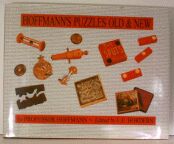 coffee table deluxe publication, edited by the late L. E. Hordern, and privately published by him in 1993. Louis Hoffmann's original book of the same title came out a century earlier. This edition includes many photographs of Hoffmann originals from Edward Hordern's collection. This book is a fascinating insight into the puzzles, some of them unrivalled for their ingenuity today. coffee table deluxe publication, edited by the late L. E. Hordern, and privately published by him in 1993. Louis Hoffmann's original book of the same title came out a century earlier. This edition includes many photographs of Hoffmann originals from Edward Hordern's collection. This book is a fascinating insight into the puzzles, some of them unrivalled for their ingenuity today.
|
Puzzles Old and New by Jerry Slocum and Jack Botermans. I just simply can't overemphasise the importance of this book to my life in the last ten years. As stated elsewhere, I had always loved maths, mathematical recreations and puzzles, going back to early sixties plastic 15-puzzles, the Tower of Hanoi, Pentominoes and the arrival of Rubik's Cube.
|
|
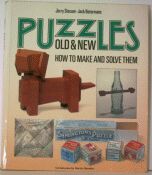
|
|
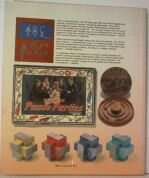
|
|
This book, more than anything else confirmed me as a puzzle collector. I had seen wrought iron disentanglement puzzles in a shop locally, but decided to try and order them cheaper from Tavern Puzzles in the US. The lady I spoke to asked if I had this book. I was dubious about buying a book unseen, but eventually went for it and never looked back. 160 pages of classic puzzles from Jerry Slocum's collection and lots of informative text.
|
|
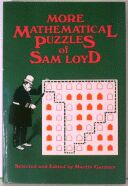
While Henry Dudeney was baffling his readers in the UK, Sam Loyd was doing it in the United States. This book, the second in the series, is compiled an edited by Martin Gardner, and details 166 of Loyd's creations. 150 original and entertaining drawings support the wide range of rec maths puzzles, wrapped in an intriguing tale.
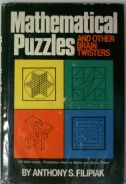 A 1978 reprint of a 1942 classic, it is subtitled '100 man-made problems and how to solve them'. It includes many pages dedicated to sliding block puzzles, as well as cube and burr puzzles, and also details on how to make your own hikimi puzzles. Gun, tank, motorcycle, automobile, plane, dog and ship are shown. There are also instructions on making glass-topped dexterity puzzles and disentanglements. A 1978 reprint of a 1942 classic, it is subtitled '100 man-made problems and how to solve them'. It includes many pages dedicated to sliding block puzzles, as well as cube and burr puzzles, and also details on how to make your own hikimi puzzles. Gun, tank, motorcycle, automobile, plane, dog and ship are shown. There are also instructions on making glass-topped dexterity puzzles and disentanglements.
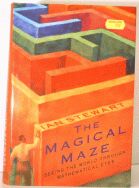 A very readable rec maths book, specially written to support the 1997 Royal Institution Christmas Lectures. Chapters on mazes, Tower of Hanoi, gaskets, goats, Turing and Fermat. A very readable rec maths book, specially written to support the 1997 Royal Institution Christmas Lectures. Chapters on mazes, Tower of Hanoi, gaskets, goats, Turing and Fermat.
 This book arrived unsolicited a year or two ago. The book is written entirely in Russian. The author, Leonid Mochalov, is trying to get it translated and published in English. The diagrams are very enticing as many of them clearly relate to new puzzles from the author. It covers sliding puzzles, burrs, dissections, edge matching, number substitutions, route puzzles, and very much more. This book arrived unsolicited a year or two ago. The book is written entirely in Russian. The author, Leonid Mochalov, is trying to get it translated and published in English. The diagrams are very enticing as many of them clearly relate to new puzzles from the author. It covers sliding puzzles, burrs, dissections, edge matching, number substitutions, route puzzles, and very much more.
This next book is a truly awesome publication. The polyhedral dissection puzzles of Stewart coffin are justifiably renowned, as masterpieces of spatial imagination. This book, by Coffin, enhances his deserved reputation. Reading him describe the techniques for creating these works of great beauty adds much to the puzzles.  I quote 'Pentagonal sticks are easy to make by first ripping three-quarter inch boards into trapezoidal sticks and then making two more cuts, all with the saw tilted 18 degrees. All the holes are drilled at an angle of 63.5 degrees to the axis of the stick, passing through the centre of the stick and parallel to one face. Determining their irregular spacing is the tricky part. It could be calculated but the author must confess he found it simpler to locate them by trial and error. Slight inaccuracies in the 210 holes can be corrected by reaming them through in the assembled or partially assembled state using a round file in an electric drill.' Yeah... I quote 'Pentagonal sticks are easy to make by first ripping three-quarter inch boards into trapezoidal sticks and then making two more cuts, all with the saw tilted 18 degrees. All the holes are drilled at an angle of 63.5 degrees to the axis of the stick, passing through the centre of the stick and parallel to one face. Determining their irregular spacing is the tricky part. It could be calculated but the author must confess he found it simpler to locate them by trial and error. Slight inaccuracies in the 210 holes can be corrected by reaming them through in the assembled or partially assembled state using a round file in an electric drill.' Yeah...
An essential book for anyone interested in mechanical puzzles and recreational mathematics.
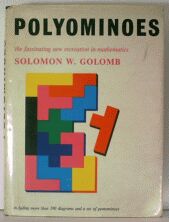 This is the classic book that originally This is the classic book that originally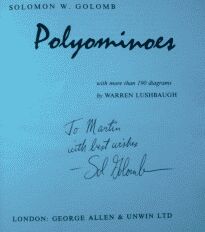 did it for me as a small boy. I must have made countless sets of cardboard pentominoes after being inspired by this book. did it for me as a small boy. I must have made countless sets of cardboard pentominoes after being inspired by this book.
It was a great honour to finally meet my mentor in 1999. The author updated the book for a subsequent edition in the mid nineties. The flyleaf is signed by Solomon with a dedication to me!
 Just two of the many (dozens?) of books Martin Gardner has written since 1935. I discovered him in my preteens and have never looked back. Just two of the many (dozens?) of books Martin Gardner has written since 1935. I discovered him in my preteens and have never looked back.  "More Puzzles, Games, Paradoxes and Other Mathematical Entertainments from Scientific American, with a Preface by Donald Knuth, A Postscript, from the Author, and a new Bibliography from Mr. Gardner, Thoughts from Readers, and 105 Drawings and Diagrams." Martin is rightly revered in every area in which he has ever involved himself. "More Puzzles, Games, Paradoxes and Other Mathematical Entertainments from Scientific American, with a Preface by Donald Knuth, A Postscript, from the Author, and a new Bibliography from Mr. Gardner, Thoughts from Readers, and 105 Drawings and Diagrams." Martin is rightly revered in every area in which he has ever involved himself.
 With more specific instructions With more specific instructions 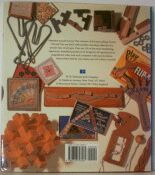 for constructing some of the puzzles, this is an excellent companion to The Book of Ingenious and Diabolical Puzzles. Many, many photos, diagrams and detailed pictures, this is subtitled, '101 classic and modern puzzles to make and solve. for constructing some of the puzzles, this is an excellent companion to The Book of Ingenious and Diabolical Puzzles. Many, many photos, diagrams and detailed pictures, this is subtitled, '101 classic and modern puzzles to make and solve.
Less photos, but more instructions. Indispensable.
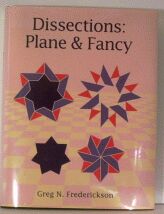 Raspberry, blueberry and cherry-tree grower Greg has compiled the definitive work on cutting stuff up and putting it together to make something else. Dissections. My friend Robert Reid has contributed many of his discoveries. Raspberry, blueberry and cherry-tree grower Greg has compiled the definitive work on cutting stuff up and putting it together to make something else. Dissections. My friend Robert Reid has contributed many of his discoveries.
Martin Gardner said of the book 'Cutting a geometrical figure into the smallest number of pieces that will rearrange into a different figure is one of the most elegant and surprising branches of recreational maths. No one knows more about this, or is more skilled at breaking old records than Greg. His book will be a classic.' It already is.
More Books Here
|

 section which discusses the number of possible shapes which can be made. Tangrams is probably one of the first mechanical puzzles I encountered as a young whipper-snapper, and I lost my enthusiasm for it by my early teens, but in recent years I have come to greatly enjoy its timeless mathematical beauty and elegance. Many of the puzzles are truly frustrating, and consequently I have several different sets. Its longevity is clear from the fact that it is constantly commercially available. I have a spare copy.
section which discusses the number of possible shapes which can be made. Tangrams is probably one of the first mechanical puzzles I encountered as a young whipper-snapper, and I lost my enthusiasm for it by my early teens, but in recent years I have come to greatly enjoy its timeless mathematical beauty and elegance. Many of the puzzles are truly frustrating, and consequently I have several different sets. Its longevity is clear from the fact that it is constantly commercially available. I have a spare copy. Shapes" is self-produced by Kevin Holmes. This A5 booklet is a work of great dedication. Kevin clearly loves the whole concept of polycube assemblies. It covers a wide range of 3x3x3, 4x4x4 and even 5x5x5 cube assemblies, designed by some of the puzzle world elite. The booklet includes hints for designing and manufacturing your own puzzles, as well as clear diagrams of each piece and a series of conventions for representing the constituent 3D pieces on paper. It also grades each puzzle for difficulty and number of solutions, and provides (sealed) solutions for most of the puzzles. My solutions are still sealed!Volume two, a significant revision, is now available.
Shapes" is self-produced by Kevin Holmes. This A5 booklet is a work of great dedication. Kevin clearly loves the whole concept of polycube assemblies. It covers a wide range of 3x3x3, 4x4x4 and even 5x5x5 cube assemblies, designed by some of the puzzle world elite. The booklet includes hints for designing and manufacturing your own puzzles, as well as clear diagrams of each piece and a series of conventions for representing the constituent 3D pieces on paper. It also grades each puzzle for difficulty and number of solutions, and provides (sealed) solutions for most of the puzzles. My solutions are still sealed!Volume two, a significant revision, is now available.



 he drab cover belies its intriguing contents. This book describes very clearly and simply, and illustrates with beautiful (sadly only black and white) photographs of models, a great number of three dimensional figures, all but a few consisting of plane faces bounded by straight lines. It includes many variations of regular solids, often obtained by truncation, stellation, dualization and compounding. 219 photos and 100 line drawings.
he drab cover belies its intriguing contents. This book describes very clearly and simply, and illustrates with beautiful (sadly only black and white) photographs of models, a great number of three dimensional figures, all but a few consisting of plane faces bounded by straight lines. It includes many variations of regular solids, often obtained by truncation, stellation, dualization and compounding. 219 photos and 100 line drawings. coffee table deluxe publication, edited by the late L. E. Hordern, and privately published by him in 1993. Louis Hoffmann's original book of the same title came out a century earlier. This edition includes many photographs of Hoffmann originals from Edward Hordern's collection. This book is a fascinating insight into the puzzles, some of them unrivalled for their ingenuity today.
coffee table deluxe publication, edited by the late L. E. Hordern, and privately published by him in 1993. Louis Hoffmann's original book of the same title came out a century earlier. This edition includes many photographs of Hoffmann originals from Edward Hordern's collection. This book is a fascinating insight into the puzzles, some of them unrivalled for their ingenuity today.


 A 1978 reprint of a 1942 classic, it is subtitled '100 man-made problems and how to solve them'. It includes many pages dedicated to sliding block puzzles, as well as cube and burr puzzles, and also details on how to make your own hikimi puzzles. Gun, tank, motorcycle, automobile, plane, dog and ship are shown. There are also instructions on making glass-topped dexterity puzzles and disentanglements.
A 1978 reprint of a 1942 classic, it is subtitled '100 man-made problems and how to solve them'. It includes many pages dedicated to sliding block puzzles, as well as cube and burr puzzles, and also details on how to make your own hikimi puzzles. Gun, tank, motorcycle, automobile, plane, dog and ship are shown. There are also instructions on making glass-topped dexterity puzzles and disentanglements. A very readable rec maths book, specially written to support the 1997 Royal Institution Christmas Lectures. Chapters on mazes, Tower of Hanoi, gaskets, goats, Turing and Fermat.
A very readable rec maths book, specially written to support the 1997 Royal Institution Christmas Lectures. Chapters on mazes, Tower of Hanoi, gaskets, goats, Turing and Fermat. This book arrived unsolicited a year or two ago. The book is written entirely in Russian. The author, Leonid Mochalov, is trying to get it translated and published in English. The diagrams are very enticing as many of them clearly relate to new puzzles from the author. It covers sliding puzzles, burrs, dissections, edge matching, number substitutions, route puzzles, and very much more.
This book arrived unsolicited a year or two ago. The book is written entirely in Russian. The author, Leonid Mochalov, is trying to get it translated and published in English. The diagrams are very enticing as many of them clearly relate to new puzzles from the author. It covers sliding puzzles, burrs, dissections, edge matching, number substitutions, route puzzles, and very much more. I quote 'Pentagonal sticks are easy to make by first ripping three-quarter inch boards into trapezoidal sticks and then making two more cuts, all with the saw tilted 18 degrees. All the holes are drilled at an angle of 63.5 degrees to the axis of the stick, passing through the centre of the stick and parallel to one face. Determining their irregular spacing is the tricky part. It could be calculated but the author must confess he found it simpler to locate them by trial and error. Slight inaccuracies in the 210 holes can be corrected by reaming them through in the assembled or partially assembled state using a round file in an electric drill.' Yeah...
I quote 'Pentagonal sticks are easy to make by first ripping three-quarter inch boards into trapezoidal sticks and then making two more cuts, all with the saw tilted 18 degrees. All the holes are drilled at an angle of 63.5 degrees to the axis of the stick, passing through the centre of the stick and parallel to one face. Determining their irregular spacing is the tricky part. It could be calculated but the author must confess he found it simpler to locate them by trial and error. Slight inaccuracies in the 210 holes can be corrected by reaming them through in the assembled or partially assembled state using a round file in an electric drill.' Yeah...  This is the classic book that originally
This is the classic book that originally did it for me as a small boy. I must have made countless sets of cardboard pentominoes after being inspired by this book.
did it for me as a small boy. I must have made countless sets of cardboard pentominoes after being inspired by this book.  Just two of the many (dozens?) of books Martin Gardner has written since 1935. I discovered him in my preteens and have never looked back.
Just two of the many (dozens?) of books Martin Gardner has written since 1935. I discovered him in my preteens and have never looked back.  "More Puzzles, Games, Paradoxes and Other Mathematical Entertainments from Scientific American, with a Preface by Donald Knuth, A Postscript, from the Author, and a new Bibliography from Mr. Gardner, Thoughts from Readers, and 105 Drawings and Diagrams." Martin is rightly revered in every area in which he has ever involved himself.
"More Puzzles, Games, Paradoxes and Other Mathematical Entertainments from Scientific American, with a Preface by Donald Knuth, A Postscript, from the Author, and a new Bibliography from Mr. Gardner, Thoughts from Readers, and 105 Drawings and Diagrams." Martin is rightly revered in every area in which he has ever involved himself. With more specific instructions
With more specific instructions  for constructing some of the puzzles, this is an excellent companion to The Book of Ingenious and Diabolical Puzzles. Many, many photos, diagrams and detailed pictures, this is subtitled, '101 classic and modern puzzles to make and solve.
for constructing some of the puzzles, this is an excellent companion to The Book of Ingenious and Diabolical Puzzles. Many, many photos, diagrams and detailed pictures, this is subtitled, '101 classic and modern puzzles to make and solve.  Raspberry, blueberry and cherry-tree grower Greg has compiled the definitive work on cutting stuff up and putting it together to make something else. Dissections. My friend Robert Reid has contributed many of his discoveries.
Raspberry, blueberry and cherry-tree grower Greg has compiled the definitive work on cutting stuff up and putting it together to make something else. Dissections. My friend Robert Reid has contributed many of his discoveries.